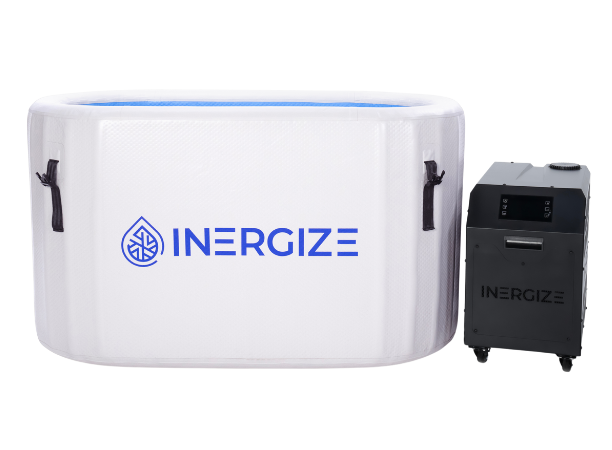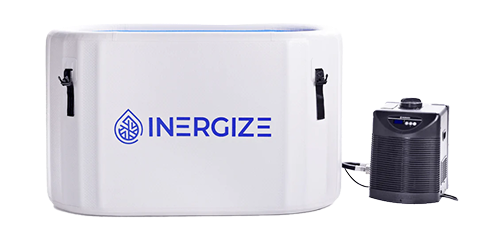Is a Cold Shower the Same as a Cold Plunge

Cold showers and cold plunges aren't the same, despite both involving cold water exposure. Cold showers typically use water between 50°F to 60°F and last 2-5 minutes, while cold plunges involve colder temperatures (37°F to 45°F) for 2-10 minutes. Cold plunges trigger more intense physiological responses, including greater cellular reactions and cardiovascular changes. They're also more effective for recovery and performance enhancement. However, cold showers are more accessible and easier to incorporate into daily routines. Both methods can improve mental health and mood, but cold plunges may offer more profound effects. Understanding these differences can help you choose the best method for your goals.
Temperature and Duration Differences
Temperature and duration mark key distinctions between cold showers and cold plunges. When you take a cold shower, you're typically exposed to water between 50°F and 60°F (10°C to 15°C) for about 2-5 minutes. This brief exposure can invigorate your body and provide some health benefits, but it's generally not long enough for significant heat absorption or thermal adaptation.
In contrast, a cold plunge involves immersing yourself in water that's much colder, usually around 37°F to 45°F (3°C to 7°C). You'll typically stay in for 2-10 minutes, allowing for more intense and prolonged exposure to the cold. This extended duration promotes greater heat absorption from your body, leading to more pronounced physiological responses.
The colder temperatures and longer durations of cold plunges trigger a more substantial thermal adaptation process in your body. Your cardiovascular system works harder to maintain core temperature, and your metabolism increases to generate heat. This more intense cold exposure can lead to greater potential benefits, such as improved circulation, reduced inflammation, and enhanced recovery from physical exertion.
Physiological Effects on the Body
While both cold showers and cold plunges affect your body, their physiological impacts differ significantly. Cold plunges typically trigger a more intense cellular response due to the sudden and complete immersion in cold water. This shock activates your body's fight-or-flight response, releasing stress hormones like norepinephrine and cortisol.
In contrast, cold showers provide a milder stimulus, gradually exposing your body to cold water. This gentler approach still initiates some physiological changes but to a lesser degree. Both methods can improve circulation, reduce inflammation, and boost your immune system, but cold plunges often lead to more pronounced effects.
The intensity of cold plunges also promotes greater metabolic adaptations. You'll likely experience a more substantial increase in brown fat activation, which can enhance your body's ability to burn calories and regulate temperature. Cold showers can still contribute to these benefits, albeit to a lesser extent.
Your cardiovascular system responds differently too. Cold plunges cause a more dramatic vasoconstriction and subsequent vasodilation, potentially leading to improved heart health and blood pressure regulation over time. Cold showers offer similar benefits but may require longer-term consistency to achieve comparable results.
Accessibility and Convenience Factors
Convenience factors play a significant role in choosing between cold showers and cold plunges. Cold showers are readily available in most homes, making them an easily accessible option for daily use. You don't need any special equipment or dedicated space, which is a significant advantage for those living in smaller homes or apartments.
On the other hand, cold plunges often require a dedicated tub or pool, which can be costly and space-consuming. However, if you have access to a cold plunge setup, it offers a more immersive experience and potentially greater benefits.
Cold showers are more energy-efficient and promote water conservation. They use less water than filling a tub and don't require energy to maintain a specific temperature. Cold plunges, while initially water-intensive, can be reused multiple times with proper maintenance.
Time is another factor to consider. Cold showers can be incorporated into your daily routine without much additional effort. Cold plunges, however, may require more time for preparation and post-plunge recovery. Consider your lifestyle and available time when choosing between these two cold therapy options.
Recovery and Performance Implications
Both cold showers and cold plunges offer significant benefits for recovery and performance enhancement. However, their effects on your body can differ due to variations in temperature, duration, and body immersion.
Cold plunges typically provide more intense exposure to cold, leading to more pronounced cardiovascular adaptations. When you immerse yourself in cold water, your blood vessels constrict, forcing your heart to work harder and improving circulation. This can enhance your overall cardiovascular fitness and potentially boost athletic performance.
Cold showers, while less intense, still stimulate metabolic rate changes. You'll experience an increase in your metabolism as your body works to maintain its core temperature. This can aid in fat burning and weight management.
For muscle recovery, cold plunges may have a slight edge. The full-body immersion can more effectively reduce inflammation and muscle soreness after intense workouts. However, cold showers can still provide notable recovery benefits, especially when targeting specific body areas.
Both methods can improve your mental toughness and stress resilience. Regular exposure to cold water can help you develop a stronger mindset, potentially translating to improved performance in various aspects of life.
Mental Health and Mood Impact
Although both cold showers and cold plunges can positively impact mental health, their effects on mood may differ slightly. Cold showers offer a quick, invigorating boost to your mental state, potentially improving your emotional self-awareness and reducing symptoms of depression. They can help you start your day feeling refreshed and alert, enhancing your cognitive focus for the tasks ahead.
Cold plunges, on the other hand, may provide a more intense and prolonged mood-enhancing effect. The extended exposure to cold water can trigger a more significant release of endorphins, leading to a stronger sense of euphoria and well-being. This prolonged immersion may also foster greater resilience to stress and anxiety, as you learn to control your breath and remain calm in uncomfortable situations.
Both practices can increase your ability to handle daily stressors and improve overall mental clarity. However, cold plunges might offer a deeper meditative experience, allowing you to cultivate mindfulness and emotional regulation more effectively. Ultimately, whether you choose cold showers or cold plunges, consistently exposing yourself to cold water can contribute to improved mental health and a more positive mood over time.
Frequently Asked Questions
Can Cold Showers or Plunges Help With Weight Loss?
You might experience some weight loss benefits from cold showers or plunges. They can boost your metabolism and increase brown fat activation. Plus, you'll enjoy an improved mood and enhanced focus, which may support your overall fitness journey.
Are There Age Restrictions for Cold Therapy Practices?
While there aren't strict age limits for cold therapy participation, you should consider your overall health and consult a doctor first. The impact of age on cold therapy effectiveness can vary, so it's essential to start slowly and listen to your body.
How Often Should One Practice Cold Showers or Plunges?
You should start with 2-3 cold showers or plunges per week. The optimal frequency varies, but don't overdo it. Aim for an ideal duration of 1-3 minutes, gradually increasing as you build tolerance. Listen to your body's signals.
Can Cold Therapy Improve Skin and Hair Health?
Cold therapy can boost your skin and hair health. You'll notice improved skin texture as cold exposure increases collagen production. It can also tighten pores, reduce inflammation, and enhance hair shine. Give it a try for potential benefits!
Are There Risks for People With Certain Medical Conditions?
Yes, there are risks for certain medical conditions. You should consider your cardiovascular health before trying cold therapy.
Conclusion
You've learned that cold showers and cold plunges aren't identical, despite some shared benefits. They differ in temperature, duration, and intensity of physiological effects. While cold showers are more accessible, cold plunges can offer deeper benefits for recovery and performance. Both can positively impact your mental health and mood. Choose the method that fits your lifestyle and goals, and remember to start gradually if you're new to cold exposure.






